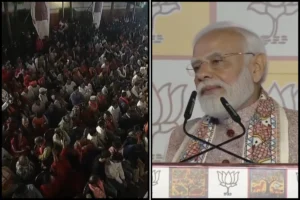
The issue of wealth inequality in India has sparked intense debates, particularly in the wake of the COVID-19 pandemic. Critics, including opposition parties, often point to the growing wealth of corporate giants such as Adani Group and Reliance Industries, arguing that this trend exemplifies crony capitalism and disadvantages the common man. However, it is crucial to recognize that the rise in the value of these corporations is not necessarily indicative of government favouritism. Rather, the underlying causes of growing income disparity extend beyond individual countries and are rooted in the structure of the global economy. This essay aims to provide a comprehensive understanding of wealth inequality, debunk misconceptions, and shed light on the initiatives taken by corporations like Reliance and Adani Groups to contribute to society through philanthropy and corporate social responsibility.
Wealth Inequality and Government Policies
Contrary to popular belief, the increase in wealth among big corporate groups does not automatically imply preferential treatment from the government. The success of companies like Adani and Ambani is primarily attributed to their entrepreneurial vision, innovation, and ability to adapt to market conditions. While it is essential to scrutinize the relationship between corporations and governments, it is unfair to attribute the entirety of their success to crony capitalism without concrete evidence.
There is a lot of innuendos spread about phenomenal success and enormous fortunes of Mukesh Ambani and Gautam Adani. But did the success come overnight or in a rapid period? Or did it take years and decades of planning, entrepreneurship, and business acumen?
Indian Corporates are the products of India’s economic liberalisation
In the early 1990s, India decided to open its economy and deregulate various sectors for private investment. At that time, Tata, Birla, Reliance, and Wipro were among the most influential corporate groups. But compared to their revenues as of today, they were then tiny.
In 1990 Aditya Birla Group’s annual turnover was around 1500 crore. In the same year, the total sales of Reliance Group were Rs 2000 crore, and net profit was just 125 crore. At that time, Azeem Premji’s Wipro group was involved in manufacturing lamps, powders, oil-based natural ingredients, and medical and diagnostic equipment. Their annual revenue was less than Rs 500 crore. Tata was the most prominent corporate Group of all. Tata Steel, Telco (now Tata Motors), Titan, TCS and many other companies were in the group portfolio. Yet, the annual revenue of Tata Group was just Rs 12000 crore in 1995.
Now let’s find out where Gautam Adani was placed circa 1990-95. In 1993 the annual report of Adani Exports recorded a sales revenue of Rs.18.88 crore and a profit after tax of Rs.78 lakh.
Compared to Tata, Birla and Reliance Adani was a relatively small firm.
Now let’s investigate the distinct business trajectory each of these groups took. There is a common thread. All of them showed immense faith in the potential of this country. They believed the country would grow rapidly with deregulation and liberalisation of the economy. So, they all invested heavily and expanded.
Tata focused on all kinds of businesses, from metals to vehicle manufacturing, consumer products, power generation, and software exports. While Azim Premji diversified from the soap and oil business into IT hardware and software exports. Aditya Birla Group focused on infrastructure, telecommunication, insurance, banking and minerals and metals. On the other hand, Reliance Group expanded its petrochemical business, set up its Jamnagar refinery in the late 90s and developed it to be the largest refinery in the world.
Gautam Adani’s story is a story of the success of Indian Infrastructure
Adani focused mainly on building core infrastructures like ports, power plants and logistics facilities. These were the areas where India was lacking woefully. Government-owned ports and logistics facilities were inadequate and pre-modern. With the Indian economy growing at an average of 7 % per annum, the country needed more ports, power plants, coal, and other core infrastructure. Adani–unlike Wipro and Tata, and Birla, who diversified from hardware to software, infra to banking– put all his entrepreneurial energy into building core infrastructure assets. One may say that he took a gamble. If the Indian economy had not grown at the expected rate, his investments could have gone belly up.
But as they say, fortune favours the brave.
The faith reposed by Adani, Tata, Birla, Ambani and Premji in the Indian economy paid them rich dividends, literally and figuratively.
Over the next two and half decades, as the Indian economy kept growing, all these corporate groups grew by leaps and bounds.
In a petition filed by Tata Son’s chairman emeritus Ratan Tata against Cyrus Mistry in the Supreme Court in January 2020, there was a telling detail about Tata Group has grown exponentially. The petition says that Shapoorji Pallonji Group’s original capital investment of Rs 69 crore in Tata Sons in 1995 grew up to Rs 58,441 crore in 2016. Additionally, Rs 872 crores were paid in dividends to SP Group over the same period. This amounts to a 40% return rate (compound annual growth rate) on capital.
Wipro’s revenues grew from around $2 million in the late 1960s to $8.4 billion in 2018-19.
When Kumar Mangalam Birla took up the role of leadership of Aditya Birla Group in 1995, the Group’s annual turnover was around $3.3 Billion. Today Aditya Birla Group is a $48 billion corporation and is on the list of Fortune 500.
Reliance Industries Limited reported a consolidated turnover of over 6.5 trillion Indian rupees in 2021.
Adani Group revenues have shot up from ₹70,463 crore five years ago to over ₹2.30 lakh crore today. Of that, an astounding 53.84% was added since 2020 (which is partly driven by acquisitions).
Thus Adani Group has indeed grown from a medium-scale import-export firm to an infrastructure conglomerate, its growth trajectory is in sync with the course of other business groups and the overall Indian economy.
The corporate groups who took calculated risks in the mid-1990s and ventured into new businesses in the hope that the Indian economy was poised to take a quantum leap have been rewarded by the markets.
Gautam Adani has made heavy investments in big greenfield infra projects. He set up the Mundra Port, several power plants, solar panel manufacturing plants, city gas distribution systems, grain storage silos, and data centres. Because Adani group consistently lived up to the challenges of executing and operating big infra projects and delivered substantial profits to its shareholders, the valuation of the shares of our listed companies has gone up. The tag of being 3rd richest bestowed on Adani is mainly because of the stock market bounties.
But the underlying assets were not built overnight but over two and half decades.
Global Nature of Income Disparity
Income inequality is a complex issue that transcends national borders and is not unique to India. It is crucial to recognize that this phenomenon exists worldwide, and numerous factors contribute to its persistence. The global economic structure, characterized by technological advancements, globalization, and market forces, plays a significant role in exacerbating wealth disparities. The forces shaping income distribution are multifaceted and require a holistic understanding rather than narrow accusations targeted at individual corporations.
Structural Causes of Income Disparity
Technological Advancements: Rapid advancements in technology have transformed industries, leading to increased productivity and efficiency. However, this has also resulted in job polarization, with routine tasks being automated, while skilled labor is in higher demand. Consequently, workers with outdated or less specialized skills face limited employment opportunities and reduced bargaining power, contributing to income inequality.
Globalization: The integration of economies has undoubtedly brought several benefits, including increased trade and economic growth. However, globalization has also created winners and losers. While large corporations have expanded their reach and capitalized on global markets, smaller enterprises and low-skilled workers in developed countries have faced intense competition, wage stagnation, and job losses.
Financialization: The growing influence of financial markets and the rise of speculative practices have led to a concentration of wealth among a few individuals. Financialization prioritizes short-term gains and shareholder value, often at the expense of long-term investment, job creation, and income distribution. This trend has contributed to the widening wealth gap in many countries.
Corporate Social Responsibility and Philanthropy
It is essential to acknowledge the efforts made by big corporations like Reliance and Adani Groups to give back to society through philanthropy and corporate social responsibility (CSR). These initiatives demonstrate a commitment to addressing societal challenges and improving the lives of the less fortunate. The focus of such efforts includes education, healthcare, environmental sustainability, and community development. By investing in these areas, corporations contribute to the overall well-being of society and support sustainable development.
Wealth inequality is undoubtedly a pressing issue, both in India and globally. However, blaming individual corporations solely based on their success is an oversimplification that ignores the broader structural causes of income disparity. While some instances of crony capitalism may exist, it is crucial to differentiate between legitimate entrepreneurial success and government favoritism. Recognizing the complex nature of income inequality and its global dimensions allows for a more comprehensive and nuanced understanding of the issue. Furthermore, it is important to acknowledge the positive contributions made by corporations like Reliance and Adani Groups through philanthropy and corporate social responsibility, as they strive to address societal challenges and promote inclusive growth. By addressing the root causes of wealth inequality and fostering a collaborative approach involving governments, businesses, and civil society, we can work towards a more equitable and sustainable future for all.




















